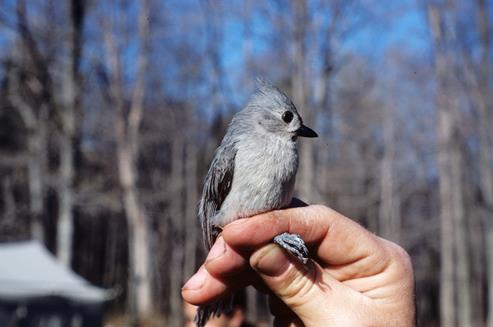This is a small bird of the east coast, with a range that extends from southern Maine through northern Florida and west to eastern Texas and eastern Minnesota. Within its range it is a pretty common bird of deciduous forests, suburbs, urban green spaces and where trees grow large enough for nesting cavities. I
t is a year-round resident that doesn’t move much from its nesting area and manages to eek out a living where other less hardy small birds, such as warblers, head south for the winter. It can wander a bit and there a sighting records from South Dakota, Quebec, and New Brunswick. Titmice are about six inches long and tip the scales at 6-9 oz.
Pairs will remain together throughout the year. They doesn’t forage much with other small birds but tends to stick to its single species groups. The male will feed the female during the courtship stage through egg hatching. Interestingly – the pair may have a “helper”, one of their young from the previous year assist them in feeding the current nestlings. They nest in tree cavities excavated by other birds but will make use of nest boxes. They like to use soft material, such as fur or hair, for their nest and are known to quickly land on the back of a dog to acquire some. If they find a snake skin they will use bits of it woven into the nest.
Five – six eggs are commonly laid – they are white and finely dotted with brown, reddish, or purple spots and incubation is complete in 12-14 days. Young fledge in 15-16 days. After the breeding season it spends lots of tie in small foraging groups that consists of the parents and their offspring and will readily eat at bird feeders.
Titmice forage mostly on insects and seeds- with insects making up to 2/3 of their diet, with caterpillars the most important prey item during the summer. Other prey items include wasps, bees, sawfly larvae, beetles, true bugs, and many insect eggs and pupae. In winter it’s interesting to watch resident birds such as this forage along tree branches. You can see them concentrating on where branches join because this is where insects lay their eggs. Titmice also spend quite a bit of the time foraging on the ground compared to other small resident birds.
The adult is gray with a crest, a black forehead just above the beak, gray underparts with a pale or whitish breast, and with flanks that are prominently rust or orange colored. Juveniles lack the black forehead and have a slightly paler crest.
Baeolophus – having a small crest and bicolor – two colored – I assume referring to the gray and rust. They have a very distinctive song of Peter-Peter-Peter that echoes through the forest and is a sure sign of spring. https://www.allaboutbirds.org/guide/Tufted_Titmouse/sounds#
he photo below was taken in early spring before leaf-out in a typical deciduous forest of northern N.J. in Stokes State Forest. I was helping a graduate student with his sampling using mist nests and we were placing identification rings on the bird’s legs. You see them flitting around in the trees all the time but when holding them you really get a sense of how small and light they are and respect them even more for bearing through those cold winter nights and managing to earn a living in the snow covered landscape.

FYI – as shown, you typically want to hold a small bird’s legs between your index and middle finger up close to their body and secured by your thumb. Just pinching their legs between a forefinger and thumb, for instance, runs a high risk of them jerking around and snapping a leg like a toothpick.
